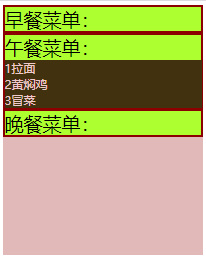jQuery标签查找练习题
题目:
- 找到本页面中id是
i1的标签 - 找到本页面中所有的
h2标签 - 找到本页面中所有的
input标签 - 找到本页面所有样式类中有
c1的标签 - 找到本页面所有样式类中有
btn-default的标签 - 找到本页面所有样式类中有
c1的标签和所有h2标签 - 找到本页面所有样式类中有
c1的标签和id是p3的标签 - 找到本页面所有样式类中有
c1的标签和所有样式类中有btn的标签 - 找到本页面中
form标签中的所有input标签 - 找到本页面中被包裹在
label标签内的input标签 - 找到本页面中紧挨在
label标签后面的input标签 - 找到本页面中id为
p2的标签后面所有和它同级的li标签 - 找到id值为
f1的标签内部的第一个input标签 - 找到id值为
my-checkbox的标签内部最后一个input标签 - 找到id值为
my-checkbox的标签内部没有被选中的那个input标签 - 找到所有含有
input标签的label标签
答案:
# 1
$('#i1')
# 2
$('h2')
# 3
$('input')
# 4
$('.c1')
# 5
$('.btn-default')
# 6
$('.c1,h2')
# 7
$('.c1,#p3')
# 8
$('.c1,.btn')
# 9
$('form input')
# 10
$('label input')
# 11
$('label input:first')
# 12
$('#p2~li')
# 13
$('#f1 input:first')
# 14
$('#my-checkbox input:last')
# 15
$('#my-checkbox input:[checked!="checked"]')
# 16
$('label:has("input")')
操作标签
-
操作类
"""
增加、删除、判断、有删无增
jQ: js:
.addClass() .classList.add()
.removeClass() .classLIst.remove()
.hasClass('c1','c2') .classList.contains()
.toggleClass() .classList.toggle()
"""
-
css操作
需求:一行代码将第一个p便签变成红色,将第二个p便签变成绿色。
jQuery链式操作
"""
<p>红色</p>
<p>绿色</p>"""
$('p').first().css('color','red').next().css('color','green');
内部原理:jQuery链式操作可以一行代码做到操作很多标签是因为jq对象调用jq方法之后返回的还是当前的jq对象,所以能继续的调用jq对象的其他方法
python代码展示原理
class Myclass(object):
def func1(self):
print('func1')
return self
def func2(self):
print('func2')
return self
...
obj = Myclass()
obj.func1().func2()
"""
func1
func2
"""
-
位置操作
# 标签相对于浏览器的位置
$('p').offset();
# 相对于父标签的位置
$('p'),opsiton()
# scrollTop()页面上下滚动条当前的值
$(window).scrollTop() # 未往下滑
# 0
$(window).scrollTop() # 滑到一定的位置
# 999
$(window).scrollTop(500) # 加了参数就是设置,滚动条跳到设置值的位置
# scrollTop()页面左右滚动条当前的值
$(window).scrollLeft() # 未往左滑
# 0
$(window).scrollLeft() # 滑到一定的位置
# 666
-
获取尺寸
$('p').height() # 获取文本高度
20
$('p').width() # 文本宽度
1670
$('p').innerHeight() # 文本+padding的高度
26
$('p').innerWidth() # 文本+padding的宽度
1674
$('p').outerHeight() # 文本+padding+borderg的高度
26
$('p').outerWidth() # 文本+padding+borderg的宽度度
1674
-
文本操作
"""
1.操作标签内部文本
获取文本
设置文本
2.操作标签内部文本和标签
获取文本和标签
设置文本和标签
jQ: js:
text() innerText
text("666") innerText = '666'
html() innerHTML
text('<h1>666</h1>') innerHTML = '<h1>666</h1>'
"""
# 操作示例
"""
<div>
<p>
111
</p>
</div
$('div').html()
"
<p>
111
</p>
"
$('div').text('666')
w.fn.init [div, prevObject: w.fn.init(1)]
$('div').html('666')
w.fn.init [div, prevObject: w.fn.init(1)]
$('div').text('<h1>666</h1>')
w.fn.init [div, prevObject: w.fn.init(1)]
$('div').html('<h1>666</h1>')
w.fn.init [div, prevObject: w.fn.init(1)]
"""
-
获取值操作
"""
jQ: js:
.val() .value
"""
# 操作示例
$('#d1').val() # 在文本框中输入"刚输入的内容",再获取值
# "刚输入的内容"
$('#d1').val('刚设置的内容') # 括号内不加参数就是获取,加了就是设置
# 文本框中显示:刚设置的内容
$('#d2').val() # 只能获取文件的路径
"C:fakepath�1_测试路由.png"
"""
jq中没有获取文件的方法,
得先将jq对象转成标签对象[0],
再获取文件对象.files,然后获取文件[0]"""
$('#d2')[0].files[0]
"""
File {name: "01_测试路由.png", lastModified: 1557043083000, lastModifiedDate: Sun May 05 2019 15:58:03 GMT+0800 (中国标准时间), webkitRelativePath: "", size: 28733, …}"""
-
属性操作
"""
1.获取属性
2.设置属性
3.删除属性
jQ: js:
attr(name) getAttribute()
attr(name,value) setAttribute()
removeAttr(name) removeAttribute()
"""
# Ps:
"""
在用变量存储对象的时候,推荐使用的命名方式,老套路了,见名知意嘛!
jQ: js:
$XXXEle(jQuery对象) XXXEle(标签对象)
"""
# 操作示例
let $pEle = $('p')
# undefined
$pEle.attr('id')
# "d1"
$pEle.attr('class')
# undefined
$pEle.attr('class','c1')
#w.fn.init [p#d1.c1, prevObject: w.fn.init(1)]
$pEle.attr('id','id666')
#w.fn.init [p#id666.c1, prevObject: w.fn.init(1)]
$pEle.attr('password','5201314')
# w.fn.init [p#id666.c1, prevObject: w.fn.init(1)]
$pEle.removeAttr('password')
w.fn.init [p#id666.c1, prevObject: w.fn.init(1)]
对于标签上有的能够看到的属性和自定义属性用atrr,而对于返回布尔值的如checkbox、radio、option等是否被选中的时候就应该用prop,再用atrr设置无效无效。
$('#d3').attr('checked','checked') # 无效
# w.fn.init [input#d3]
$('#d2').prop('checked') # id为2的默认未选中
# false
$('#d3').prop('checked') # id为3的默认选中
# true
$('#d2').prop('checked',true) # 选中
# w.fn.init [input#d3]
$('#d3').prop('checked',false) # 取消选中
# w.fn.init [input#d3]
-
文档处理
"""
1.创建标签
2.往标签内部追加子标签
...
jQ: js:
$('<p>') createElement('p')
append() appendChild()
...
"""
# 操作示例
let $pEle = $('<p>')
$pEle.text('你好啊 草莓要不要来几个?')
$pEle.attr('id','d3')
$('#d1').append($pEle)
$pEle.appendTo($('#d1')) # 两者等价,内部尾部追加
$('#d1').prepend($pEle)
$pEle.prependTo($('#d1')) # 两者等价,内部头部追加
$('#d2').after($pEle)
$pEle.insertAfter($('#d1')) # 放在某个标签后面
$('#d1').before($pEle)
$pEle.insertBefore($('#d2')) # 放在某个标签前面
$('#d1').remove() # 将标签从DOM树中删除标签,
$('#d1').empty() # 清空标签内部所有的内容,标签还在
jQuery事件
-
两种绑定事件的方式
# 第一种
$('#d1').click(function(){
alert('第一种')
})
# 第二种(功能更强大,支持事件委托)
$('#d1').on('click',function(){
alert('第二种')
})
-
克隆事件
<button id="d1">影分身</button>
<script>
$('#d1').on('click',function () {
// console.log(this) // this指代是当前被操作的标签对象
// $(this).clone().insertAfter($('body')) // clone默认情况下只克隆html和css 不克隆事件
$(this).clone(true).insertAfter($('body')) // 括号内加true即可克隆事件
})
</script>
自定义模态框
<script src="https://cdn.bootcss.com/jquery/3.3.1/jquery.min.js"></script>
<style>
.cover{
position: fixed;
top:0;
left: 0;
right:0;
bottom:0;
background-color: darkgrey;
z-index: 99;
}
.model {
400px;
height:200px;
position: fixed;
left: 50%;
bottom:50%;
margin-top: 100px;
margin-left: 200px;
background-color:wheat;
z-index: 100;
}
.hide {
display:none;
}
</style>
</head>
<body>
<div class="hide">我是最底层的</div>
<div class="cover hide">
</div>
<div class="model hide">
<label for="l1">
<input type="text" id="l1">username:
</label><label for="l2">
<input type="password" id="l2">password:
<button class="c2">回去</button>
</label>
</div>
<button class="c1">出来</button>
<script>
$('.c1').on('click',function(){
let coverEle = $('.cover')[0] // 获得单个的标签对象
let modelEle = $('.model')[0]
$(coverEle).removeClass("hide") // 再将单个的标签对象转成jq对象,操作属性
$(modelEle).removeClass("hide")
})
$('.c2').on('click',function(){
let coverEle = $('.cover')[0]
let modelEle = $('.model')[0]
$(coverEle).addClass("hide")
$(modelEle).addClass("hide")
})
</script>
</body>
-
左侧菜单栏
<head>
<meta charset="UTF-8">
<title>Title</title>
<script src="https://cdn.bootcss.com/jquery/3.3.1/jquery.min.js"></script>
<style>
.menu {
background-color: #e2b9b9;
400px;
height:500px;
position:fixed;
}
.title {
font-size: 38px;
color:black;
background-color: greenyellow;
border:3px darkred solid;
}
.items {
font-size: 16px;
color: #eecaca;
background-color: #42310f;
}
.hide {
display: none;
}
</style>
</head>
<body>
<div class="menu">
<div class="title">早餐菜单:
<div class="items hide">1包子</div>
<div class="items hide">2馒头</div>
<div class="items hide">3豆浆</div>
</div>
<div class="title">午餐菜单:
<div class="items hide">1拉面</div>
<div class="items hide">2黄焖鸡</div>
<div class="items hide">3冒菜</div>
</div>
<div class="title">晚餐菜单:
<div class="items hide">1火锅</div>
<div class="items hide">2烤串</div>
<div class="items hide"></div>
</div>
</div>
<script>
$('.title').on('click',function(){
$('.items').addClass('hide')
$(this).children().removeClass('hide')
})
// 尝试用一行代码搞定上面的操作
效果图:

-
返回顶部
<script>
$(window).scroll(function () {
if($(window).scrollTop() > 300){
$('#d1').removeClass('hide')
}else{
$('#d1').addClass('hide')
}
})
</script>
-
自定义登录校验
在获取用户的用户名和密码的时候 用户如果没有填写 应该给用户展示提示信息
<p>username:
<input type="text" id="username">
<span style="color: red"></span>
</p>
<p>password:
<input type="text" id="password">
<span style="color: red"></span>
</p>
<button id="d1">提交</button>
<script>
let $userName = $('#username')
let $passWord = $('#password')
$('#d1').click(function () {
// 获取用户输入的用户名和密码 做校验
let userName = $userName.val()
let passWord = $passWord.val()
if (!userName){
$userName.next().text("用户名不能为空")
}
if (!passWord){
$passWord.next().text('密码不能为空')
}
})
$('input').focus(function () {
$(this).next().text('')
})
</script>
-
input实时监控
<input type="text" id="d1">
<script>
$('#d1').on('input',function () {
console.log(this.value)
})
</script>
-
hover事件
<script>
// $("#d1").hover(function () { // 鼠标悬浮 + 鼠标移开
// alert(123)
// })
$('#d1').hover(
function () {
alert('我来了') // 悬浮
},
function () {
alert('我溜了') // 移开
}
)
</script>
- 键盘按下事件
<script>
$(window).keydown(function (event) {
console.log(event.keyCode)
if (event.keyCode === 16){
alert('你按了shift键')
}
})
</script>